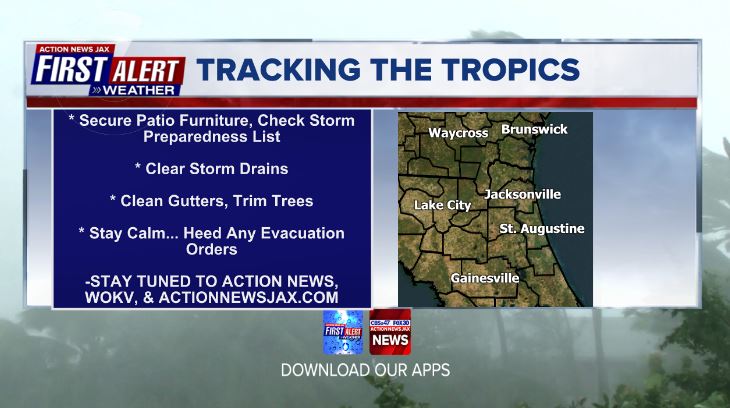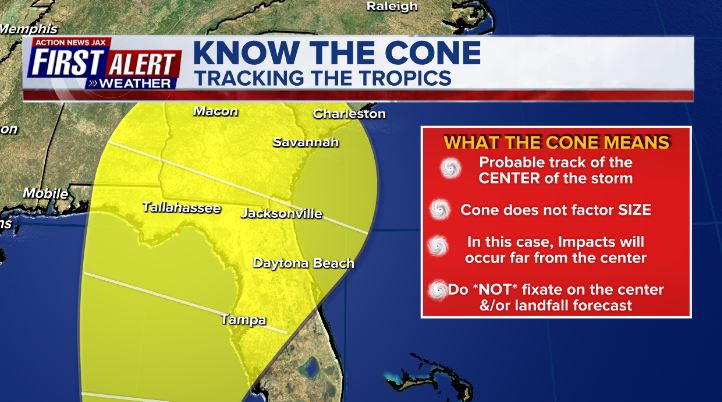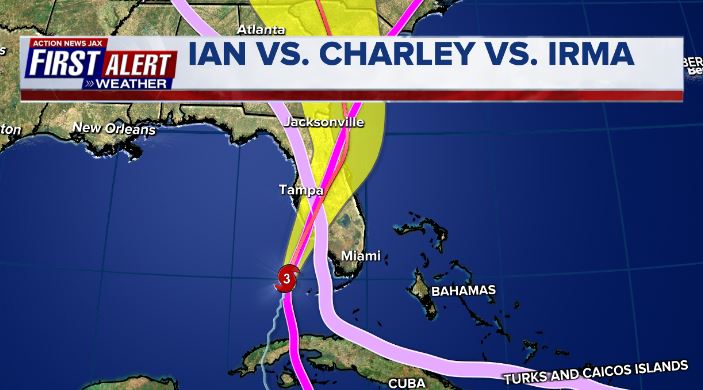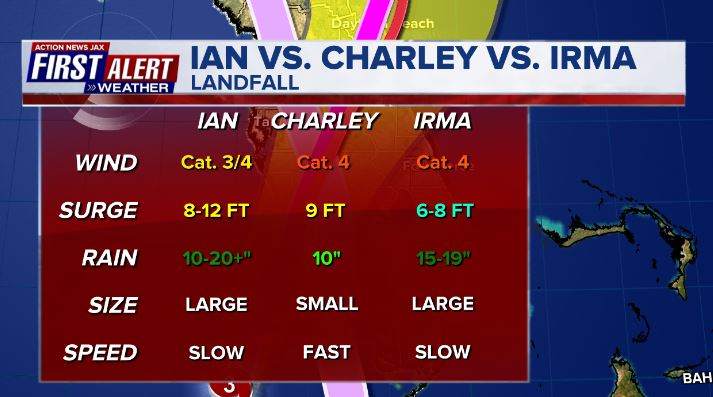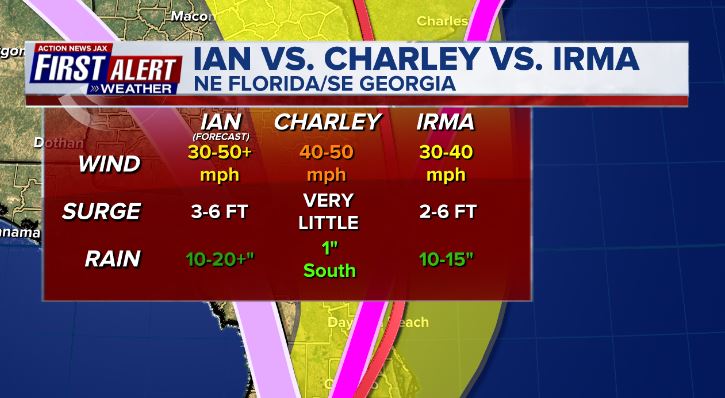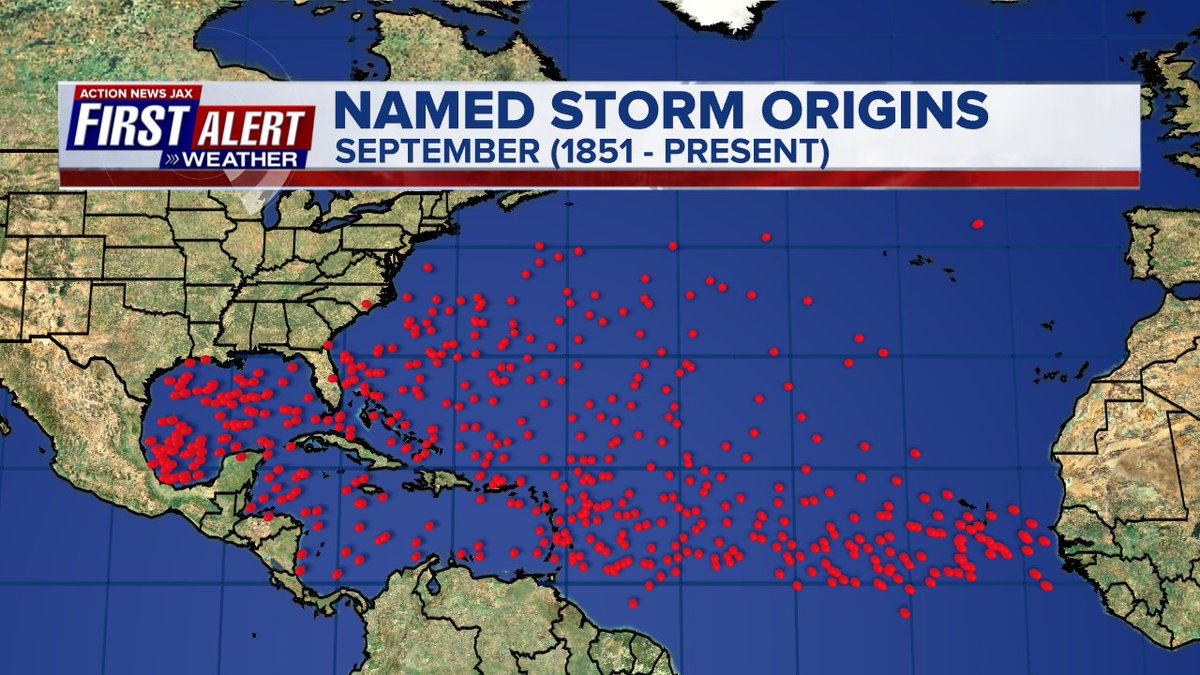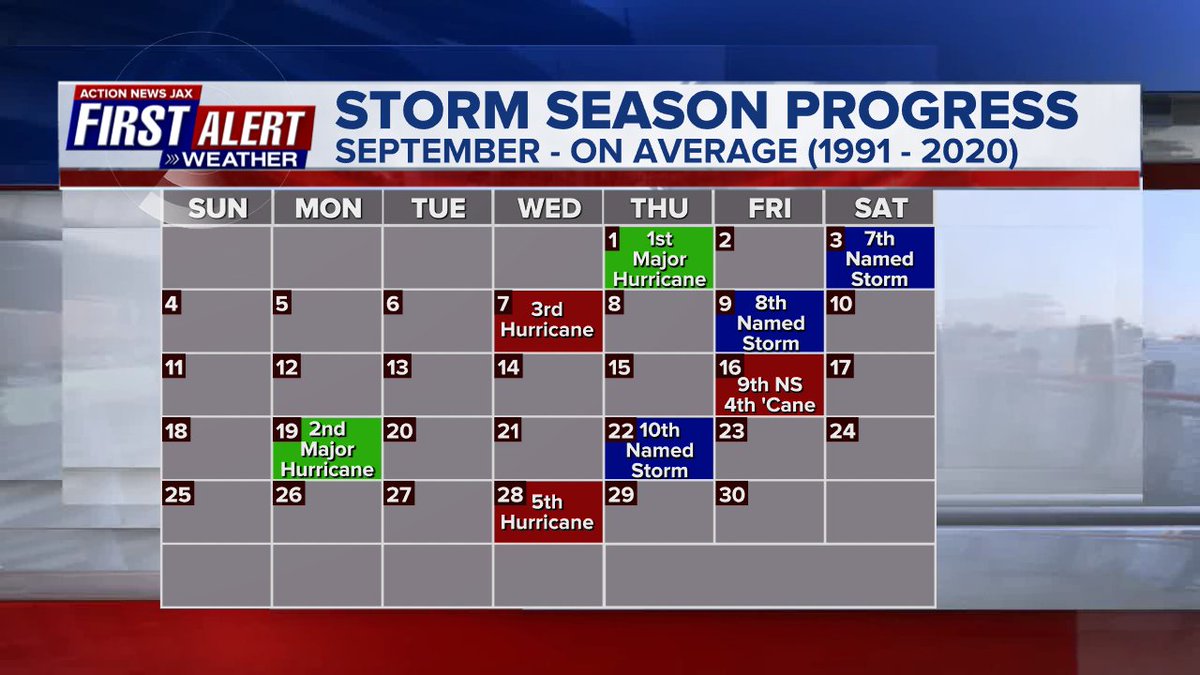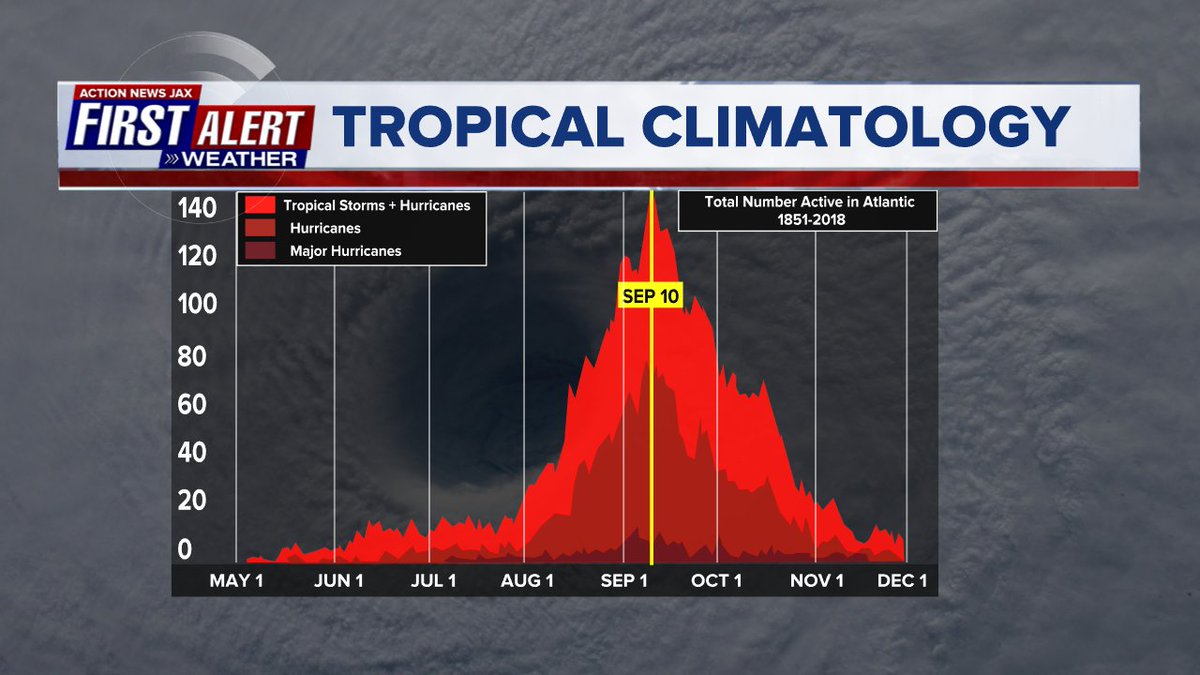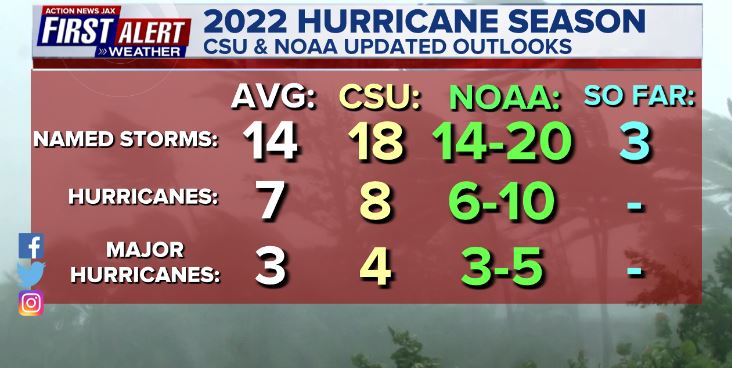Jacksonville, Fl. — The “Buresh Bottom Line”: Always be prepared!.....First Alert Hurricane Survival Guide... City of Jacksonville Preparedness Guide... Georgia Hurricane Guide.
STAY INFORMED: Get the * FREE * First Alert Weather app
FREE NEWS UPDATES, ALERTS: Action News Jax app for Apple | For Android
WATCH “Preparing for the Storm”
WATCH “The Ins & Outs of Hurricane Season”
READ the First Alert Hurricane Center “Survival Guide”
LISTEN & WATCH “Surviving the Storm” - WOKV Radio & Action News Jax
***** ALWAYS CHECK & RE-CHECK THE LATEST FORECAST & UPDATES! *****
REMEMBER WHEN A TROPICAL STORM OR HURRICANE IS APPROACHING: Taping windows is *NOT* helpful & will not keep glass from breaking.
Realize the forecast cone (”cone of uncertainty”) is the average forecast error over a given time - out to 5 days - & *does not* indicate the width of the storm &/or damage that might occur.
** FIRST ALERT! ** - Anyone living in - or traveling to - Florida & the Southeast U.S. should stay up to date on the latest forecast as Ian moves across Florida. A reminder to NOT focus too much on the exact center or intensity forecast. **
One should be careful about determining the threat to life & property based on the category of the storm & whether or not Ian is weakening. Dangerous impacts are imminent for a good part of Fl. It’s possible that the storm surge will be a category or so higher than what one might expect &/or higher than is forecast (in other words, a Cat. 1 might have a Cat. 2 storm surge, etc.).... along with the possible record flooding in some areas.
LOCAL - NORTHEAST FLORIDA/SOUTHEAST GEORGIA - POTENTIAL IMPACTS FROM IAN *BASED ON THE CURRENT FORECAST PATH*:
Tropical Storm WARNING & Storm Surge WARNING for the St. Johns River including downtown Jacksonville....& the coast & intracoastal + inland areas of Duval, St. Johns, Nassau, Clay & Putnam, coastal Camden & Glynn Counties in Ga....Hurricane WATCH for coastal NE Fl. & coastal SE Ga.
* The exact timing & intensity of any & all Ian impacts for NE Fl./SE Ga. will be dependent on the exact location & strength of Ian in reference to Jacksonville & will, of course, be subject to change. While a hurricane WATCH has been issued for the NE Fl./SE Ga. coast, impacts from Ian similar to expectations of the last couple days.
* Multiple rain bands - still not necessarily directly a result of Ian (enhanced by onshore flow) - arrived in parts of St. Johns, Duval, Clay & Putnam Co. Wed. spreading slowly from southwest to northeast. Some areas north of I-10 - especially more inland - have had little rainfall which will continue to be the case into at least Thursday morning.
* Potential rainfall: 8-12″... 15″+ for some areas with max amounts as high as 20″+! for Southern St. Johns, Eastern Putnam & Flagler Co. The heaviest rainfall potential will be along & south & east of a line from Brunswick to St. Marys to Bryceville to Macclenny to Lake Butler where the strongest rain bands are expected to be the most frequent & persistent with a possible possible bullseye over approximately Southeast Duval southward through much of St. Johns Co. & west to Eastern Clay & Eastern Putnam Co. possibly including Nocatee, St. Augustine, Palm Valley, Julington Creek, Fruit Cove, Bayard, Picolata, Switzerland, Elkton, Hastings, Palatka, East Palatka, Bostwick, Crescent Beach, Mainland & areas in-between. Inland areas - Baker, Columbia & Union Co. in Fl... & Ware, Pierce & Charlton Co. in Ga. - Lake City to Olustee to Baxter to Folkston to Waycross to Nahunta & nearby areas of Ga.: 1-3″, locally 4″+.
Due to the strong & persistent winds out of the east & northeast, some east facing windows, doors & vents of homes & businesses could be compromised by water penetration.
*** The forecast rainfall from approximately I-95 to the coast may be historical causing record flooding in some instances in addition to standing water & widespread “inundation” (big bodies of water several inches to several feet deep) in areas that usually - & possibly never - flood. ***
The tropical moisture surging north combined with onshore winds (out of the east) ahead of Ian will bring spread heavy rain from south to north through Thu. This will start to saturate the already wet ground across the area leading to the more serious flooding issues midday Thu./Fri. - in particular - as heavy Ian rain bands move across the area & potentially “train” across some areas. The saturated soil may also lead to trees being more easily uprooted by winds that otherwise may not be much of a problem. The local area has dried out some over the past 7-10 days but the very wet Aug./early Sept. has still left soils essentially saturated... + we’re coming off a week of higher than avg. tides partially due to the new moon cycle & astronomically higher than avg. tides, so there’s a good deal of water “in the system” that will be added to in the coming days. The winds out of the east will also help force more water into inlets, the intracoastal, streams & rivers before the heaviest rain even begins. Flooding along the St. Johns River & its tributaries will occur as well as a long Black Creek & its forks in Clay Co.
We’ll have to keep a close eye on downtown Jacksonville as - given the current forecast & now Ian staying south of Jacksonville before moving northward near the coast - strong easterly flow Thu. into Friday may “pile up” water at the bend near the Acosta Bridge (where it goes from flowing to more southwest) causing water to overflow into parts of downtown & nearby areas... in addition to the heavy rain & high tidal departures. This situation is different than Irma in 2017 as Irma stayed to the west causing a strong & long fetch of southerly flow up the St. Johns River into downtown Jacksonville. The current Ian forecast is somewhat more similar to Matthew in ‘16 (exception is that Matthew moved parallel & offshore the coast upon approach from the southeast vs. Irma moving south of Jax then northward just offshore). Those impacted by flooding during either Irma in ‘17 or Matthew in ‘16 should consider alternative shelter & beware of rapidly rising water at any time with the greatest threat from later Thu. through late Fri. into Fri. night. It would appear - with the track south of Jacksonville that downtown Jacksonville would *not* have an exact repeat of the Irma flooding but could still see significant water levels. The forecast trend for Ian’s center is a good deal more south & east which will help some in that there would not be as long a fetch of winds directly north up the St. Johns River into d’town Jacksonville. However, a long period of strong winds out of the east will compensate - at least some - & make flooding worse for the area east to the coast. The lower reaches of the St. Johns River in parts of Clay & St. Johns Co. will also be subject to some “sloshing” effect which could increase the surge values.
And finally.... larger rivers will take longer to crest & may rise through the weekend into next week.
Those along Black Creek & its tributaries in Clay Co. should be aware of the flood threat & be ready to evacuate, if necessary. Follow county officials advise on if & when to evacuate. Be smart... don’t tempt fate... & be careful gauging the flood threat based on previous storms.
* Storm surge is expected to average at least 3-5 feet at the Fl. coast & along the St. Johns River (for comparison, St. Johns River storm surge caused by Irma was 5-6 feet in downtown Jacksonville in Sept., 2017 & was 5-7+ feet during Matthew at the coast in Oct., 2016). It is possible - if everything (heavy rain, high tide, strong east winds) comes together at the wrong time - there *could* be record flooding in some areas. The storm surge forecast is a significant 4-6 feet for the southeast coast of Georgia from St. Marys to St. Simons Island/Jekyll Island & Brunswick.
* Seas & surf will increase through the week. Double digit breakers at local beaches can be expected Thu./Fri. with a very high rip current risk. Breakers at the beaches from 9-14+ feet Thu... 8-12+ feet Fri.... slowly subsiding over the weekend but with dangerous rip currents continuing.
* Gusty winds arrived Wed. & will steadily increase Thu./Fri. *At the moment* tropical storm force (39+ mph) sustained winds will be possible in some areas... favoring near & south of I-10 & the coast with a few hurricane force (74+ mph) wind gusts possible at times. Strongest winds will occur south of Highway 16 & east of I-95 as well as up & down the coast including the beaches & along waterways. Keep in mind that bridges are usually closed when sustained winds reach 40 mph but local officials may make “the call” at anytime depending on local conditions & forecasts.
* Isolated waterspouts & tornadoes can be expected through early Fri.
* At least some power outages should be anticipated, a widespread loss of power is possible for some counties - especially east of I-95 & over Putnam & Flagler Co. Realize utility companies will not be able to begin long term repairs until winds decrease & flooding subsides.
Ian:
Tropical wave - ‘98-L’ that moved off of Africa last week is moving over the Southern Caribbean & Central Caribbean & was upgraded to tropical depression #9 Friday .... to tropical storm “Ian” Fri. evening... then to a hurricane early Mon. with a landfall over Western Cuba early Tue. as a Cat. 3 hurricane & made landfall southwest of - & near - Ft. Myers Wed. afternoon. Ian formed from a classic wave in that it formed from a complex of intense storms over Africa... encountered hostile conditions (shear & dry air) for days before finding more favorable conditions. Virtually all ingredients were in place for maintaining Ian’s intensity over the SE Gulf. Unfortunately an eyewall replacement cycle was completed overnight resulting in a rapidly intensifying hurricane Wed. upon approach to the southwest coast of Florida. Due to the hurricane’s size & nearly 2 days as a major hurricane, impacts in the area south of Tampa will be even more severe damage than Cat. 4 Charley that hit the same general area in 2004. Imagery below from CIMMS integrated microwave imagery:
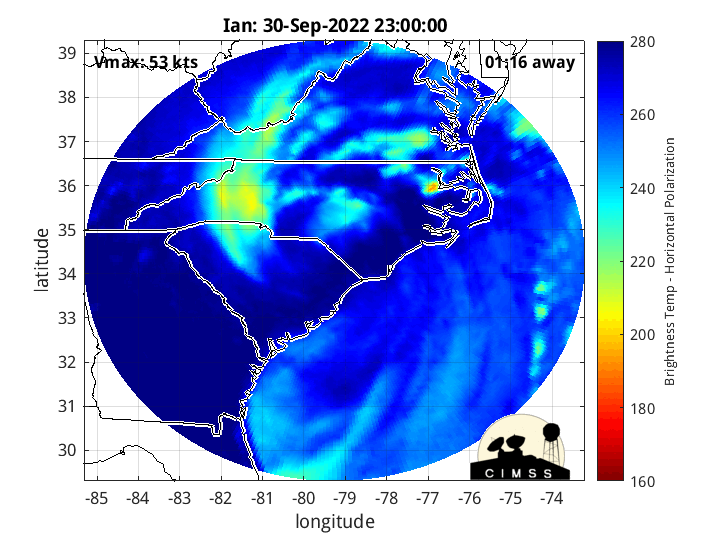
Friction from land & increasing shear & dry air will weaken Ian but still with a wide wind field on its journey across Fl. through Thu. afternoon while “sniffing” out the ocean again to the east.
One should be careful about determining the threat to life & property based on the category of the storm & whether or not Ian is weakening. Dangerous impacts are imminent for a good part of Fl. It’s possible that the storm surge will be a category or so higher than what one might expect - than the actual category of the storm - for parts of the Fl. west coast... & even other parts of Florida.
Ian will be weaker once to the east coast but do not let one’s guard down!
Steering currents:
(2) A fairly broad trough over the Eastern U.S. + an upper level disturbance over the Western Gulf will help dictate the northeast track across Fl. As the upper trough over the Eastern U.S. departs & lifts out to the northeast, steering currents near Ian will weaken causing the hurricane to slow - especially near & after the Fl. landfall. A cold front dipping into Fl. has stalled between I-4 & Highway 16 (Central Fl.) & will focus the heaviest, most persistent rainfall along & north of the front.

Movement summary:
Ian will at least stay far away from recently hard hit Puerto Rico & Dominican Republic. The time table - *for right now* after slamming Florida’s west/southwest coast Wed.... moving northeast to near Orlando by early Thu.... to near Daytona Beach Thu. afternoon... to east of Jacksonville early Fri. then another landfall near Savannah Fri. afternoon as a tropical storm.
It doesn’t look Ian will be able to significantly strengthen over the far Western Atlantic Fri. but may manage to remain at least steady state with the help of the warm but relatively shallow shelf water not to mention landfall was near Cat. 5 intensity, so Ian will take a little longer to lose strength. Even though the time over the Atlantic water will not be long (approximately 20-25 hours), Ian will be fairly close to the Gulf Stream with still decent outflow over the “top”. With that in mind, the NHC has posted a hurricane WATCH for coastal NE Fl. & coastal SE Ga. but - again - don’t the terminology get in the way of the First Alert Forecast & expected impacts.




NHC interactive inundation forecast * here *





Spaghetti plots includes ensembles of the models. Definite shift east recently:


If Ian’s forecast track continues to trend west, the rainfall forecast should decrease - at least some:



Tampa radar imagery:


Radar imagery from S. Fl. Water Management District:

Integrated Microwave Imager, CIMSS:


Increasing shear now for Ian as tropical cyclone moves to near & across Fl.:

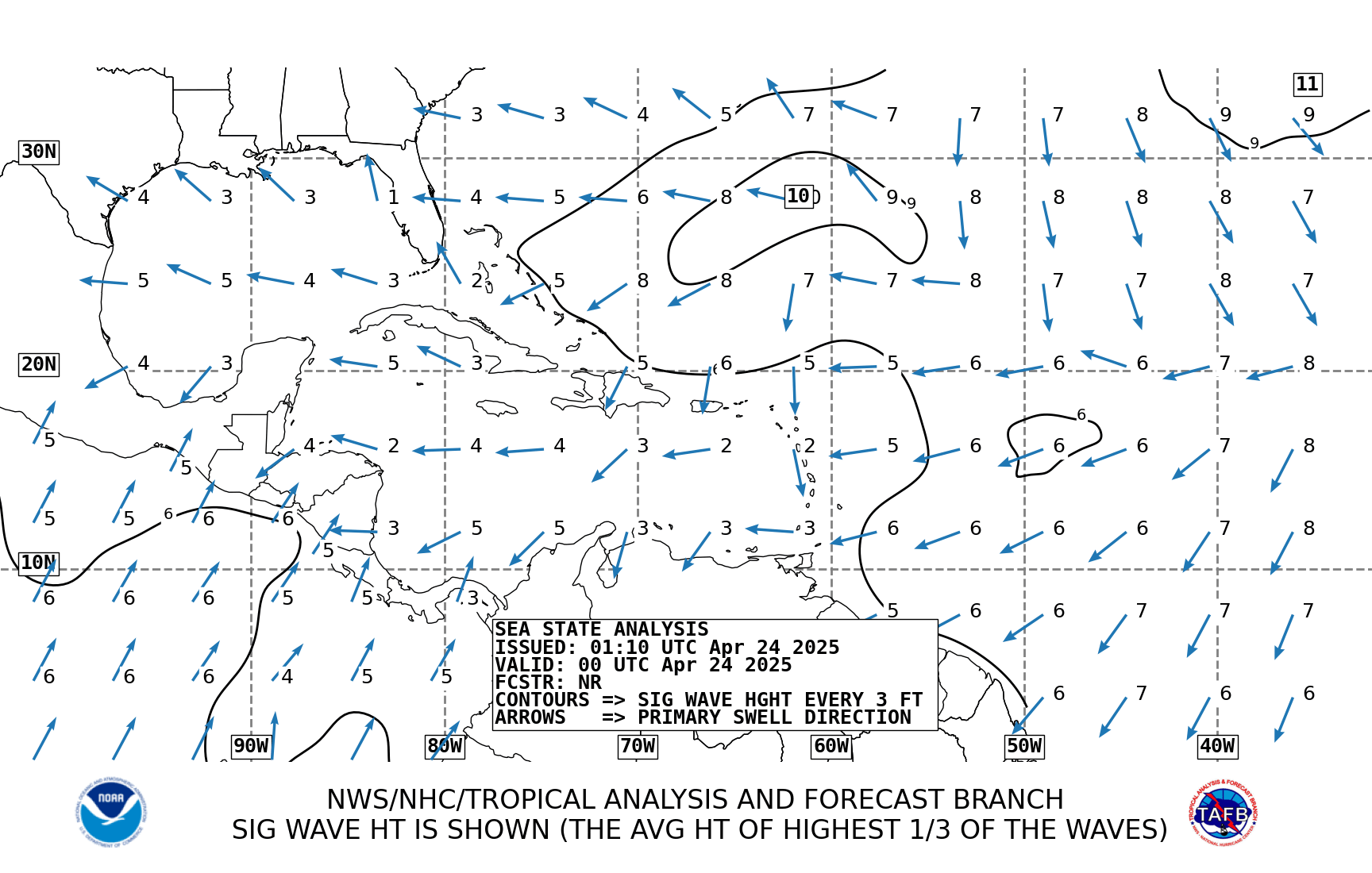
Comparison of tracks & impacts (at landfall & over/near Jacksonville) between Cat. 4 Charley in 2004, Cat. 4 Irma in 2017 & the forecast for Ian:
Elsewhere....
Tropical depression #11 has formed over the Eastern Atlantic. #11 might manage to become a tropical storm while moving NW then more northward before encountering hostile conditions in the form of strong shear & drier air which should cause dissipation over the open Atlantic by at least early next week if not over the weekend.




Water vapor loop shows plenty of mid & upper level moisture (white & green areas) across a good part of the Atlantic Basin:



September origins:
Averages below based on climatology for the Atlantic Basin through September. This season so far is well below avg.:

Wind shear:




Saharan dust spreads west each year from Africa by the prevailing winds (from east to west over the Atlantic). Dry air - yellow/orange/red/pink. Widespread dust is indicative of dry air that can impede the development of tropical cyclones. However, sometimes “wanna’ be” waves will just wait until they get to the other side of - or away from - the plume then try to develop if other conditions are favorable. In my personal opinion, way too much is made about the presence of Saharan dust & how it relates to tropical cyclones. In any case, we’ve had several large dust plumes spread west to the Caribbean & Gulf with the peak of Saharan dust typically in June & July.

2022 names..... “Julia” is the next name on the Atlantic list (names are picked at random by the World Meteorological Organization... repeat every 6 years). Historic storms are retired [Florence & Michael in ’18... Dorian in ’19 & Laura, Eta & Iota in ‘20 & Ida in ‘21]). In fact, this year’s list of names is rather infamous with “Charley”, “Frances”, “Jeanne” & “Ivan” retired from the ‘04 list (all hit Fl.) & “Matthew” was retired in 2016. The WMO decided - beginning last year - that the Greek alphabet will be no longer used & instead there will be a supplemental list of names if the first list is exhausted (has only happened three times - 2005, 2020 & 2021). The naming of tropical cyclones began on a consistent basis in 1953. More on the history of naming tropical cyclones * here *.





East Atlantic:





Mid & upper level wind shear (enemy of tropical cyclones) analysis (CIMMS). The red lines indicate strong shear:
Water vapor imagery (dark blue indicates dry air):

Deep oceanic heat content over the Gulf, Caribbean & deep tropical Atlantic:

Sea surface temp. anomalies:


SE U.S. surface map:

Surface analysis centered on the tropical Atlantic:

Surface analysis of the Gulf:

Caribbean:

GFS wave forecast at 48 & 72 hours (2 & 3 days):
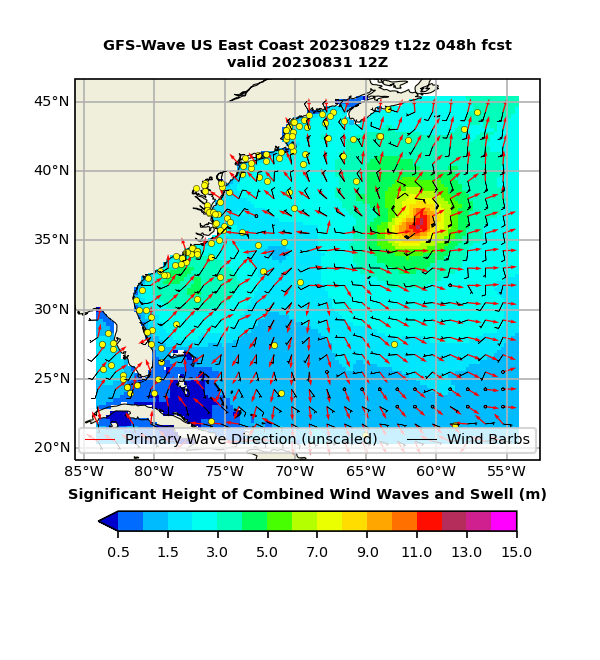

Atlantic Basin wave period forecast for 24, 48 & 72 hours respectively:




Updated Atlantic seasonal forecast from early Aug. - NOAA & CSU:
The East Pacific:


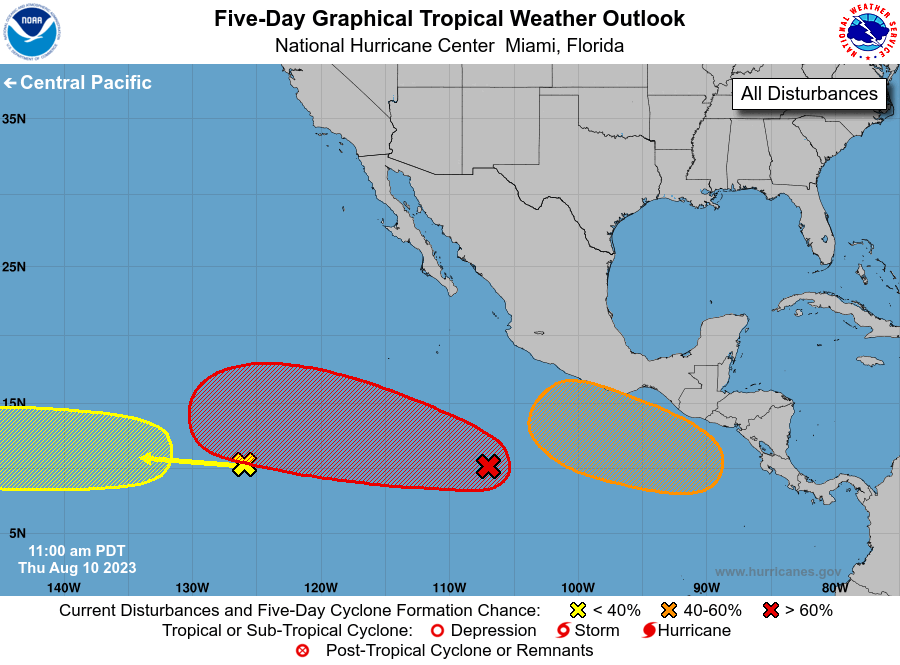
West Pacific:

Global tropical activity:



Typhoon “Noru” hit Vietnam & is weakening:

“Kulap” will stay well east of Japan:

Another tropical cyclone over the W. Pacific to stay east of Japan while turning northeast:

Cox Media Group


